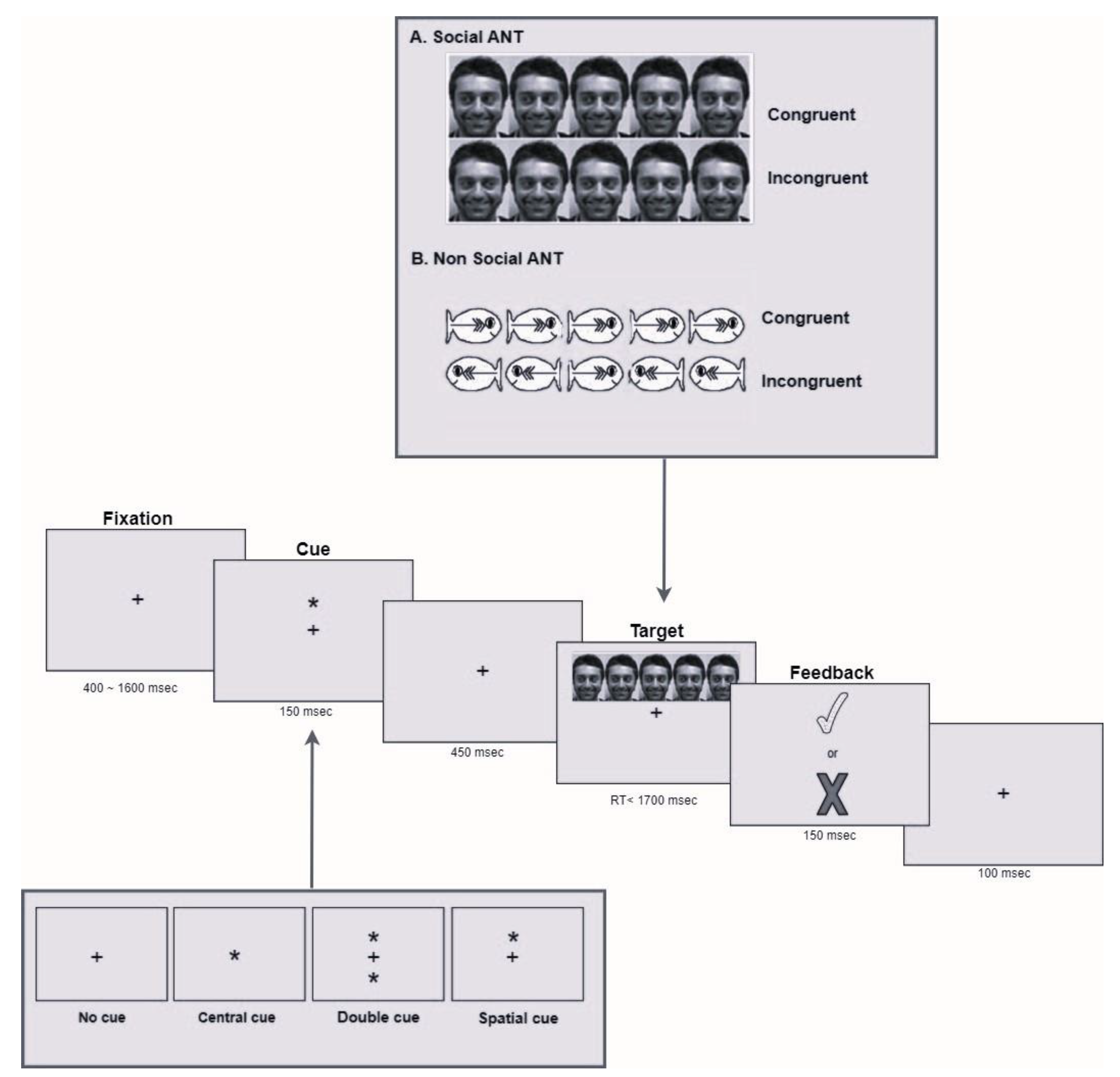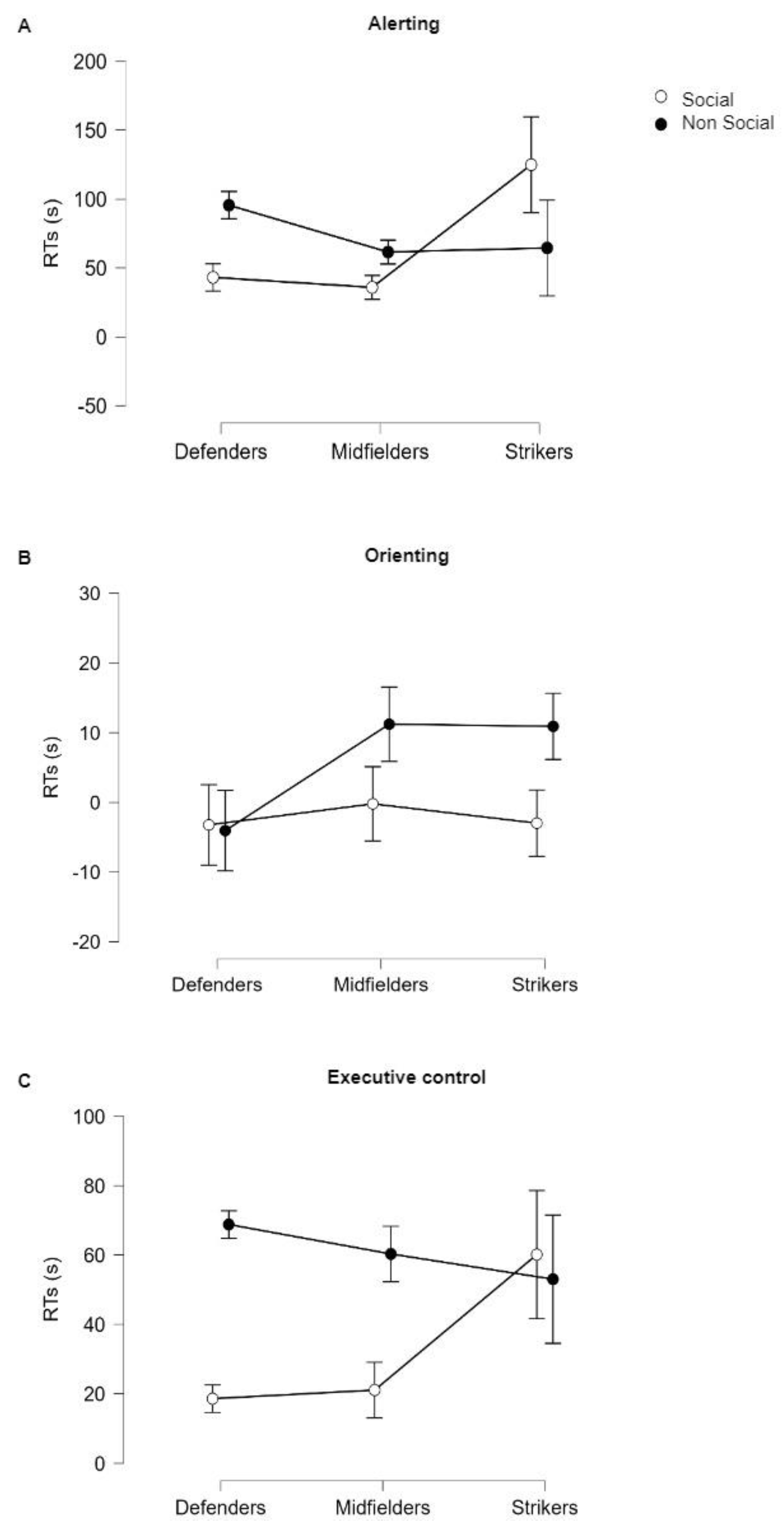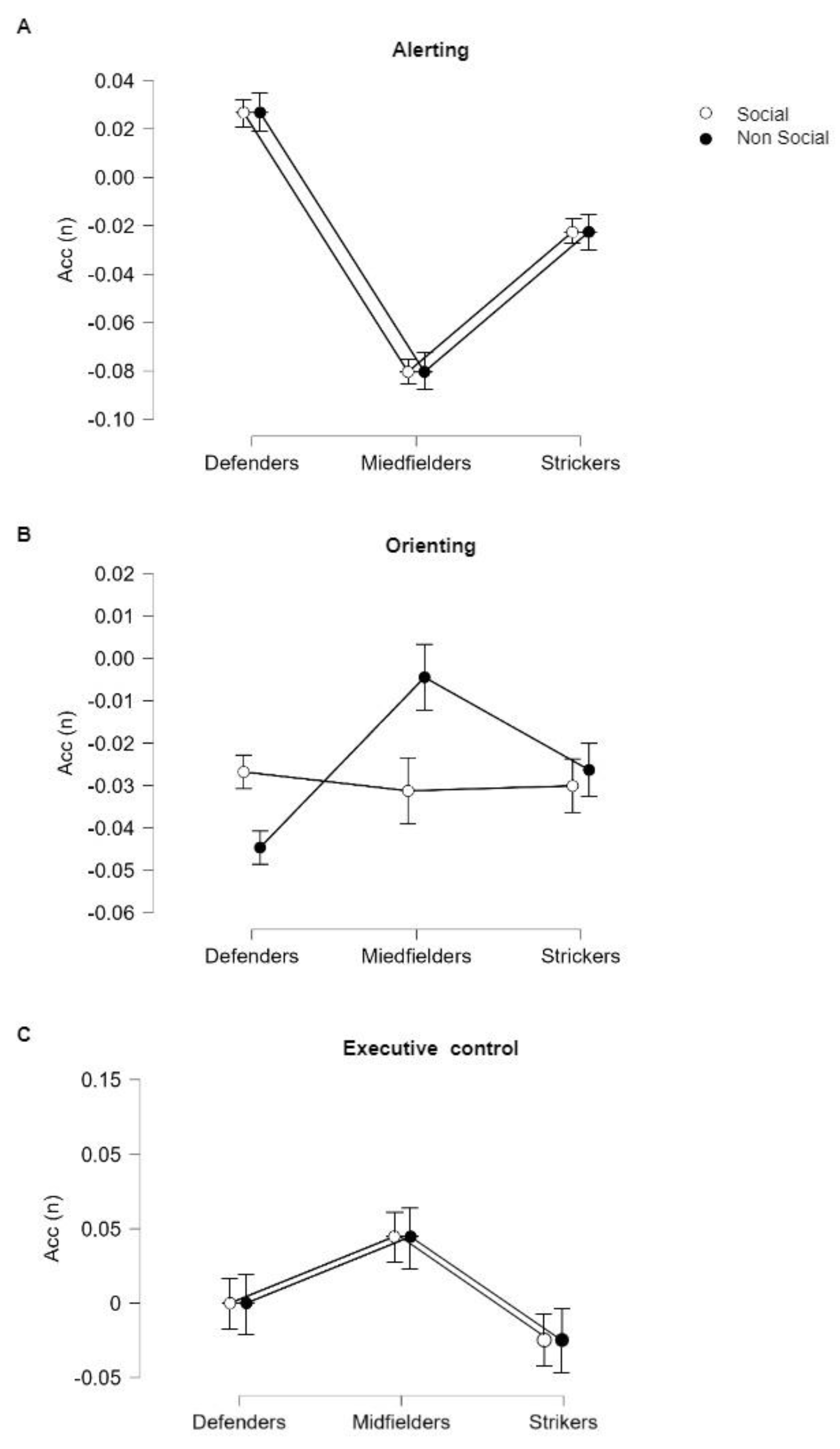The Effects of Social Processing and Role Type on Attention Networks: Insights from Team Ball Athletes
Abstract
1. Introduction
2. Materials and Methods
2.1. Participants
2.2. Attention Network Test (ANT)
2.2.1. Apparatus
2.2.2. Stimuli
2.2.3. Procedure
2.2.4. Data Analysis
2.3. Statistical Analysis
3. Results
3.1. Stimulus × Role Effects on Reaction Times (RTs)
3.2. Stimulus × Role Effects on Accuracy (Acc)
4. Discussion
5. Conclusions
Author Contributions
Funding
Institutional Review Board Statement
Informed Consent Statement
Data Availability Statement
Conflicts of Interest
References
- Davies, D.R.; Parasuraman, R. Arieties of Attention Eds.; Academic Press Series in Cognition and Perception; Academic Press: Orlando, FL, USA, 1984; ISBN 978-0-12-544970-0. [Google Scholar]
- Posner, M.I.; Petersen, S.E. The Attention System of the Human Brain. Annu. Rev. Neurosci. 1990, 13, 25–42. [Google Scholar] [CrossRef]
- Fougnie, D. The Relationship between Attention and Working Memory. New Res. Short-Term Mem. 2008, 1, 45. [Google Scholar]
- Fan, J.; McCandliss, B.D.; Sommer, T.; Raz, A.; Posner, M.I. Testing the Efficiency and Independence of Attentional Networks. J. Cogn. Neurosci. 2002, 14, 340–347. [Google Scholar] [CrossRef]
- Fan, J.; Gu, X.; Guise, K.G.; Liu, X.; Fossella, J.; Wang, H.; Posner, M.I. Testing the Behavioral Interaction and Integration of Attentional Networks. Brain Cogn. 2009, 70, 209–220. [Google Scholar] [CrossRef] [PubMed]
- Mann, D.T.Y.; Williams, A.M.; Ward, P.; Janelle, C.M. Perceptual-Cognitive Expertise in Sport: A Meta-Analysis. J. Sport Exerc. Psychol. 2007, 29, 457–478. [Google Scholar] [CrossRef]
- Fegatelli, D.; Giancamilli, F.; Mallia, L.; Chirico, A.; Lucidi, F. The Use of Eye Tracking (ET) in Targeting Sports: A Review of the Studies on Quiet Eye (QE). In Intelligent Interactive Multimedia Systems and Services 2016; Pietro, G.D., Gallo, L., Howlett, R.J., Jain, L.C., Eds.; Springer International Publishing: Cham, Switzerland, 2016; pp. 715–730. [Google Scholar]
- Chirico, A.; Fegatelli, D.; Galli, F.; Mallia, L.; Alivernini, F.; Cordone, S.; Giancamilli, F.; Pecci, S.; Tosi, G.M.; Giordano, A.; et al. A Study of Quiet Eye’s Phenomenon in the Shooting Section of “Laser Run” of Modern Pentathlon. J. Cell. Physiol. 2019, 234, 9247–9254. [Google Scholar] [CrossRef] [PubMed]
- Janelle, C.M.; Fawver, B.J.; Beatty, G.F. Emotion and Sport Performance. In Handbook of Sport Psychology; John Wiley & Sons, Ltd: Hoboken, NJ, USA, 2020; pp. 254–298. ISBN 978-1-119-56812-4. [Google Scholar]
- Montuori, S.; D’Aurizio, G.; Foti, F.; Liparoti, M.; Lardone, A.; Pesoli, M.; Sorrentino, G.; Mandolesi, L.; Curcio, G.; Sorrentino, P. Executive Functioning Profiles in Elite Volleyball Athletes: Preliminary Results by a Sport-Specific Task Switching Protocol. Hum. Mov. Sci. 2019, 63, 73–81. [Google Scholar] [CrossRef] [PubMed]
- Fontani, G.; Lodi, L.; Felici, A.; Migliorini, S.; Corradeschi, F. Attention in Athletes of High and Low Experience Engaged in Different Open Skill Sports. Percept. Mot. Skills 2006, 102, 791–805. [Google Scholar] [CrossRef]
- Voss, M.W.; Kramer, A.F.; Basak, C.; Prakash, R.S.; Roberts, B. Are Expert Athletes ‘Expert’ in the Cognitive Laboratory? A Meta-Analytic Review of Cognition and Sport Expertise. Appl. Cogn. Psychol. 2010, 24, 812–826. [Google Scholar] [CrossRef]
- Giancamilli, F.; Galli, F.; Chirico, A.; Fegatelli, D.; Mallia, L.; Palombi, T.; Cordone, S.; Alivernini, F.; Mandolesi, L.; Lucidi, F. When the Going Gets Tough, What Happens to Quiet Eye? The Role of Time Pressure and Performance Pressure during Basketball Free Throws. Psychol. Sport Exerc. 2022, 58, 102057. [Google Scholar] [CrossRef]
- Williams, A.M.; Jackson, R.C. Anticipation in Sport: Fifty Years on, What Have We Learned and What Research Still Needs to Be Undertaken? Psychol. Sport Exerc. 2019, 42, 16–24. [Google Scholar] [CrossRef]
- Vickers, J.N.; Reeves, M.-A.; Chambers, K.L.; Martell, S. Decision Training: Cognitive Strategies for Enhancing Motor Performance. In Skill Acquisition in Sport; Routledge: Abingdon, UK, 2004; ISBN 978-0-203-64656-4. [Google Scholar]
- Corbetta, M.; Shulman, G.L. Control of Goal-Directed and Stimulus-Driven Attention in the Brain. Nat. Rev. Neurosci. 2002, 3, 201–215. [Google Scholar] [CrossRef]
- Birmingham, E.; Kingstone, A. Human Social Attention. In Progress in Brain Research; Elsevier: Amsterdam, The Netherlands, 2009; Volume 176, pp. 309–320. ISBN 978-0-444-53426-2. [Google Scholar]
- Federico, F. Natural Environment and Social Relationship in the Development of Attentional Network. Front. Psychol. 2020, 11, 1345. [Google Scholar] [CrossRef] [PubMed]
- Nummenmaa, L.; Calder, A.J. Neural Mechanisms of Social Attention. Trends Cogn. Sci. 2009, 13, 135–143. [Google Scholar] [CrossRef] [PubMed]
- Capozzi, F.; Ristic, J. How Attention Gates Social Interactions. Ann. New York Acad. Sci. 2018, 1426, 179–198. [Google Scholar] [CrossRef] [PubMed]
- Dalmaso, M.; Castelli, L.; Galfano, G. Social Modulators of Gaze-Mediated Orienting of Attention: A Review. Psychon. Bull. Rev. 2020, 27, 833–855. [Google Scholar] [CrossRef] [PubMed]
- Federico, F.; Marotta, A.; Martella, D.; Casagrande, M. Development in Attention Functions and Social Processing: Evidence from the Attention Network Test. Br. J. Dev. Psychol. 2017, 35, 169–185. [Google Scholar] [CrossRef] [PubMed]
- Chaddock, L.; Pontifex, M.B.; Hillman, C.H.; Kramer, A.F. A Review of the Relation of Aerobic Fitness and Physical Activity to Brain Structure and Function in Children. J. Int. Neuropsychol. Soc. 2011, 17, 975–985. [Google Scholar] [CrossRef]
- Kramer, A.F.; Erickson, K.I. Effects of Physical Activity on Cognition, Well-Being, and Brain: Human Interventions. Alzheimer’s Dement. 2007, 3, S45–S51. [Google Scholar] [CrossRef]
- Federico, F.; Marotta, A.; Adriani, T.; Maccari, L.; Casagrande, M. Attention Network Test—The Impact of Social Information on Executive Control, Alerting and Orienting. Acta Psychol. 2013, 143, 65–70. [Google Scholar] [CrossRef]
- Rueda, M.R.; Posner, M.I.; Rothbart, M.K. Attentional Control and Self-Regulation. In Handbook of Self-Regulation: Research, Theory, and Applications; The Guilford Press: New York, NY, USA, 2004; pp. 283–300. ISBN 978-1-57230-991-3. [Google Scholar]
- Martella, D.; Casagrande, M.; Lupiáñez, J. Alerting, Orienting and Executive Control: The Effects of Sleep Deprivation on Attentional Networks. Exp. Brain Res. 2011, 210, 81–89. [Google Scholar] [CrossRef] [PubMed]
- Geva, R.; Zivan, M.; Warsha, A.; Olchik, D. Alerting, Orienting or Executive Attention Networks: Differential Patters of Pupil Dilations. Front. Behav. Neurosci. 2013, 7, 145. [Google Scholar] [CrossRef] [PubMed]
- Dichter, G.S.; Belger, A. Social Stimuli Interfere with Cognitive Control in Autism. NeuroImage 2007, 35, 1219–1230. [Google Scholar] [CrossRef] [PubMed]
- Schultz, R.T. Developmental Deficits in Social Perception in Autism: The Role of the Amygdala and Fusiform Face Area. Int. J. Dev. Neurosci. 2005, 23, 125–141. [Google Scholar] [CrossRef] [PubMed]
- Bindemann, M.; Burton, A.M.; Langton, S.R.H.; Schweinberger, S.R.; Doherty, M.J. The Control of Attention to Faces. J. Vis. 2007, 7, 15. [Google Scholar] [CrossRef]
- Langton, S.R.H.; Law, A.S.; Burton, A.M.; Schweinberger, S.R. Attention Capture by Faces. Cognition 2008, 107, 330–342. [Google Scholar] [CrossRef] [PubMed]
- Driver, J.; Davis, G.; Ricciardelli, P.; Kidd, P.; Maxwell, E.; Baron-Cohen, S. Gaze Perception Triggers Reflexive Visuospatial Orienting. Vis. Cogn. 1999, 6, 509–540. [Google Scholar] [CrossRef]
- Marotta, A.; Lupiáñez, J.; Casagrande, M. Investigating Hemispheric Lateralization of Reflexive Attention to Gaze and Arrow Cues. Brain Cogn. 2012, 80, 361–366. [Google Scholar] [CrossRef]
- Friesen, C.K.; Kingstone, A. The Eyes Have It! Reflexive Orienting Is Triggered by Nonpredictive Gaze. Psychon. Bull. Rev. 1998, 5, 490–495. [Google Scholar] [CrossRef]
- Riechelmann, E.; Raettig, T.; Böckler, A.; Huestegge, L. Gaze Interaction: Anticipation-Based Control of the Gaze of Others. Psychol. Res. 2021, 85, 302–321. [Google Scholar] [CrossRef]
- Martell, S.G.; Vickers, J.N. Gaze Characteristics of Elite and Near-Elite Athletes in Ice Hockey Defensive Tactics. Hum. Mov. Sci. 2004, 22, 689–712. [Google Scholar] [CrossRef] [PubMed]
- Yarrow, K.; Brown, P.; Krakauer, J.W. Inside the Brain of an Elite Athlete: The Neural Processes That Support High Achievement in Sports. Nat. Rev. Neurosci. 2009, 10, 585–596. [Google Scholar] [CrossRef] [PubMed]
- Rizzolatti, G.; Sinigaglia, C. The Mirror Mechanism: A Basic Principle of Brain Function. Nat. Rev. Neurosci. 2016, 17, 757–765. [Google Scholar] [CrossRef] [PubMed]
- Aglioti, S.M.; Cesari, P.; Romani, M.; Urgesi, C. Action Anticipation and Motor Resonance in Elite Basketball Players. Nat. Neurosci. 2008, 11, 1109–1116. [Google Scholar] [CrossRef]
- Wu, Y.; Zeng, Y.; Zhang, L.; Wang, S.; Wang, D.; Tan, X.; Zhu, X.; Zhang, J.; Zhang, J. The Role of Visual Perception in Action Anticipation in Basketball Athletes. Neuroscience 2013, 237, 29–41. [Google Scholar] [CrossRef]
- Schumacher, N.; Schmidt, M.; Wellmann, K.; Braumann, K.-M. General Perceptual-Cognitive Abilities: Age and Position in Soccer. PLoS ONE 2018, 13, e0202627. [Google Scholar] [CrossRef] [PubMed]



| No. (n) | Age (Mean ± SD) | BMI (Mean ± SD) | |
|---|---|---|---|
| Strikers | 38 | 21.01 ± 3.61 | 23.73 ± 1.43 |
| Midfielders | 32 | 20.03 ± 3.23 | 23.55 ± 2.34 |
| Defenders | 32 | 18.50 ± 1.34 | 22.75 ± 1.45 |
| Factors | F(df) | p | |
|---|---|---|---|
| Alerting | Stimulus | 0.092(1,99) | 0.762 |
| Role | 1.791(2,99) | 0.172 | |
| Stimulus × Role | 2.109(2,99) | 00.080 | |
| Orienting | Stimulus | 3.604(1,99) | 0.061 |
| Role | 0.888(2,99) | 0.416 | |
| Stimulus × Role | 1.109(2,99) | 0.334 | |
| Executive Control | Stimulus | 6.761(1,99) | 0.011 * |
| Role | 1.081(2,99) | 0.343 | |
| Stimulus × Role | 2.921(2,99) | 0.059 |
| Factors | F(df) | p | |
|---|---|---|---|
| Alerting | Stimulus | 0.087(1,99) | 0.923 |
| Role | 17.306(2,99) | <0.001 *** | |
| Stimulus * Role | 0.098(2,99) | 0.751 | |
| Orienting | Stimulus | 0.684(1,99) | 0.410 |
| Role | 0.750(2,99) | 0.475 | |
| Stimulus * Role | 6.022(2,99) | 0.003 ** | |
| Executive Control | Stimulus | 0.074(1,99) | 0.687 |
| Role | 0.429(2,99) | 0.635 | |
| Stimulus * Role | 7.089(2,99) | 0.024 * |
Disclaimer/Publisher’s Note: The statements, opinions and data contained in all publications are solely those of the individual author(s) and contributor(s) and not of MDPI and/or the editor(s). MDPI and/or the editor(s) disclaim responsibility for any injury to people or property resulting from any ideas, methods, instructions or products referred to in the content. |
© 2023 by the authors. Licensee MDPI, Basel, Switzerland. This article is an open access article distributed under the terms and conditions of the Creative Commons Attribution (CC BY) license (https://creativecommons.org/licenses/by/4.0/).
Share and Cite
Passarello, N.; Mellone, M.; Sorrentino, P.; Chirico, A.; Lucidi, F.; Mandolesi, L.; Federico, F. The Effects of Social Processing and Role Type on Attention Networks: Insights from Team Ball Athletes. Brain Sci. 2023, 13, 476. https://doi.org/10.3390/brainsci13030476
Passarello N, Mellone M, Sorrentino P, Chirico A, Lucidi F, Mandolesi L, Federico F. The Effects of Social Processing and Role Type on Attention Networks: Insights from Team Ball Athletes. Brain Sciences. 2023; 13(3):476. https://doi.org/10.3390/brainsci13030476
Chicago/Turabian StylePassarello, Noemi, Michela Mellone, Pierpaolo Sorrentino, Andrea Chirico, Fabio Lucidi, Laura Mandolesi, and Francesca Federico. 2023. "The Effects of Social Processing and Role Type on Attention Networks: Insights from Team Ball Athletes" Brain Sciences 13, no. 3: 476. https://doi.org/10.3390/brainsci13030476
APA StylePassarello, N., Mellone, M., Sorrentino, P., Chirico, A., Lucidi, F., Mandolesi, L., & Federico, F. (2023). The Effects of Social Processing and Role Type on Attention Networks: Insights from Team Ball Athletes. Brain Sciences, 13(3), 476. https://doi.org/10.3390/brainsci13030476






